
No, Triumph did not make a fabulous chrome emblem for its Gloria bicycles. The mascot is for the Triumph Gloria range of sporting saloon cars that Triumph introduced in 1933 …after discontinuing their Gloria Cycle range soon after this particular machine was built.
It seems Triumph considered the Gloria name to be just too good to waste on a humble bicycle…
…but as there are not many Triumph-Gloria Roadsters around now, I fitted a winged goddess emblem to the front mudguard anyway.
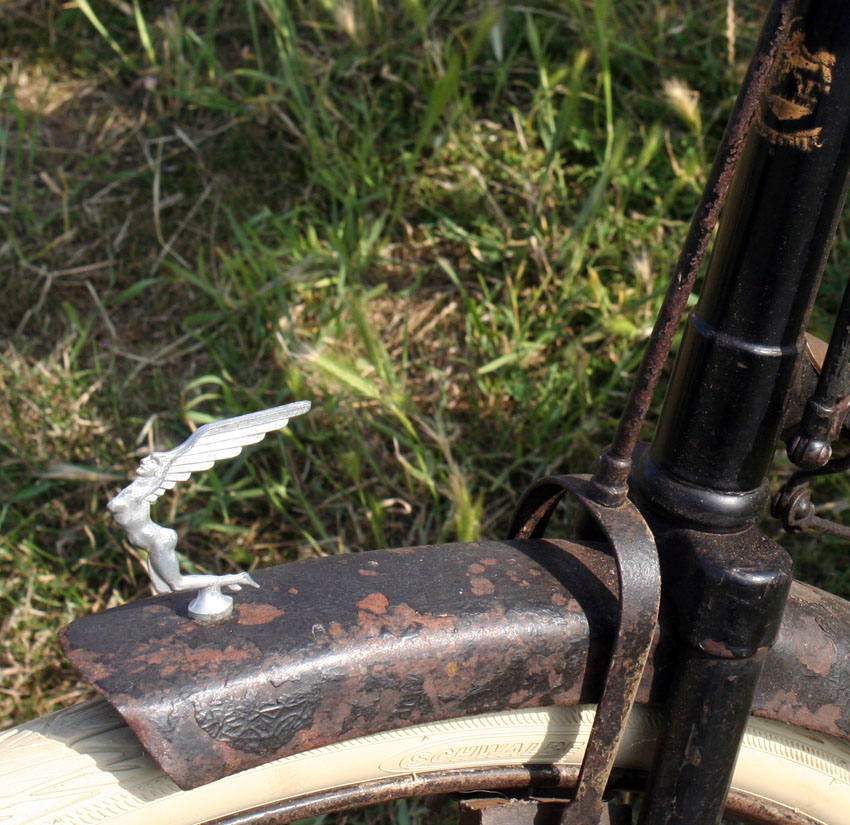

1931 Triumph-Gloria 26 inch ‘Model H’ Full Roadster
Sturmey Archer ‘Model K’ Three-Speed
26″ Frame
28″ Wheels
Full Accessory Set: Dynamo, lights, bell, rear carrier, reflector, bag, inflator pump

All Triumph bicycles are rare and sought-after. It’s not surprising when you consider that the company was Great Britain’s primary motorcycle manuafacturer: vintage motorcycle collectors compete with bicycle enthusiasts to find vintage Triumphs of every type. Vintage car collectors also prize Triumph Gloria bicycles as they are even rarer than the fabulous 1930s Triumph Gloria Sports Saloons.
As a result of feedback from their cycle agents, Triumph tried making cheaper machines, marketing a ‘Standard’ model in 1905. But, of course, everything made in the same factory went through the same expensive processes and quality control; so selling cheaper machines just made their top-of-the-range products look overpriced.
Using a different factory, and made with different fittings, Triumph’s Gloria Cycle Co was another solution to selling bicycles that were cheaper than Triumph Cycle Co‘s own products, but still taking advantage of their top reputation, distribution network and agencies worldwide. Gloria bicycles used a variety of frames and parts. Some frames came from the Triumph factory – these had their numbers stamped in the usual Triumph location above the bottom bracket; frames from other suppliers had their serial numbers stamped at the top of the seat post. Components on Glorias are a mixture of those made by Triumph and other suppliers, presumably depending on what surplus parts Triumph had at the time.
Early Triumphs are large machines, and this 26″ frame Beast is no exception. The paintwork is original and very well-preserved, with its original transfer (decal) on the headstock (faded but readable), as well as on Triumph’s patent oil-bath chaincase (above and below).

Anyone who has experienced the luxury of a Rolls Royce understands why it is more expensive than an Austin Seven. The build quality and attention to detail mean that not only does the vehicle last longer and require less attention, but it is also an ultimate driving experience. Likewise the output from Great Britain’s top cycle manufacturers.
Sunbeam, Lea Francis, Centaur, Beeston Humber and Triumph were the world’s most expensive bicycles in their day for a very simple reason …they were built to last and they ride so well. Having become a separate class of ‘classic’ – reflecting the similar distinction of top car and motorcycle marques – they were a good investment when they were new, and they still are today.
This example is very original, with excellent unrestored paintwork. The only things I’ve replaced are the tyres and inner tubes …and the Gloria Winged Goddess emblem on the mudguard. Mechanical restoration was not needed, but this Triumph-Gloria Full Roadster has been serviced and is ready to ride.
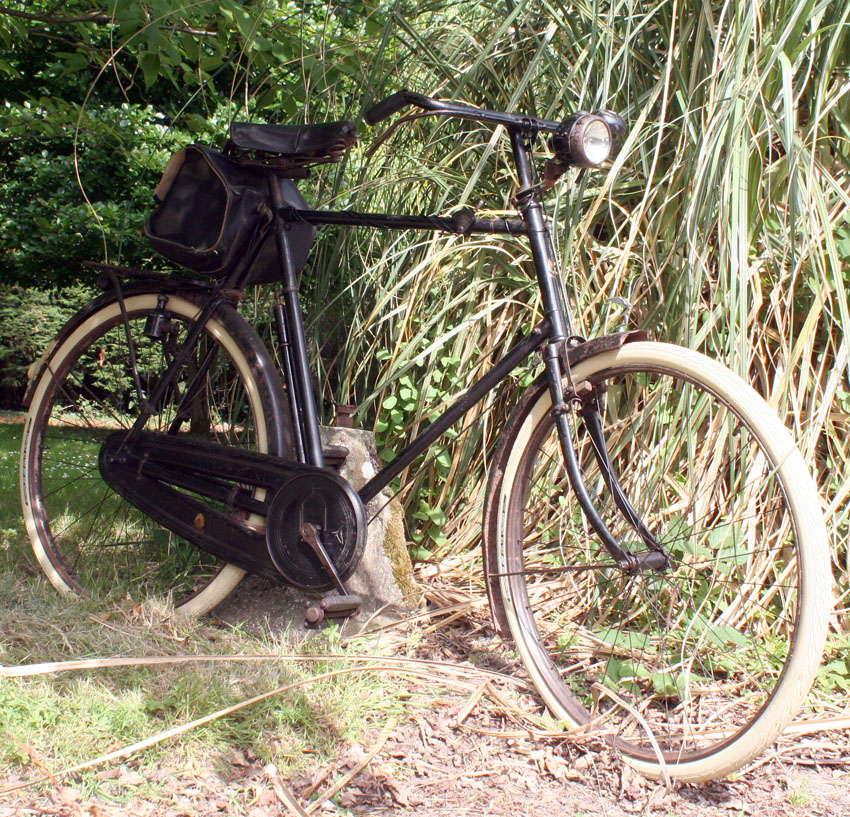
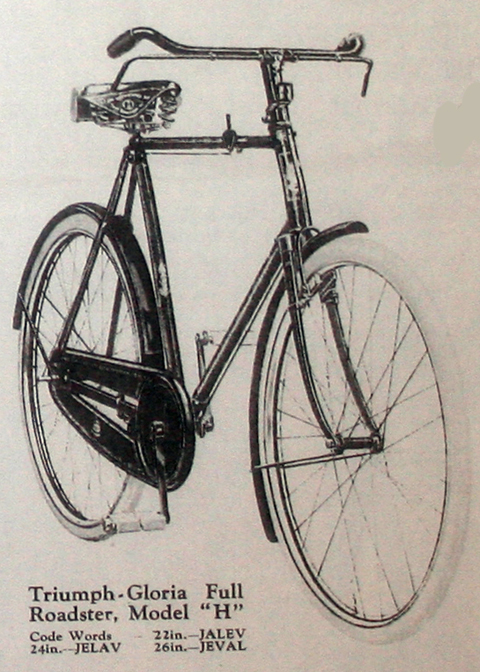
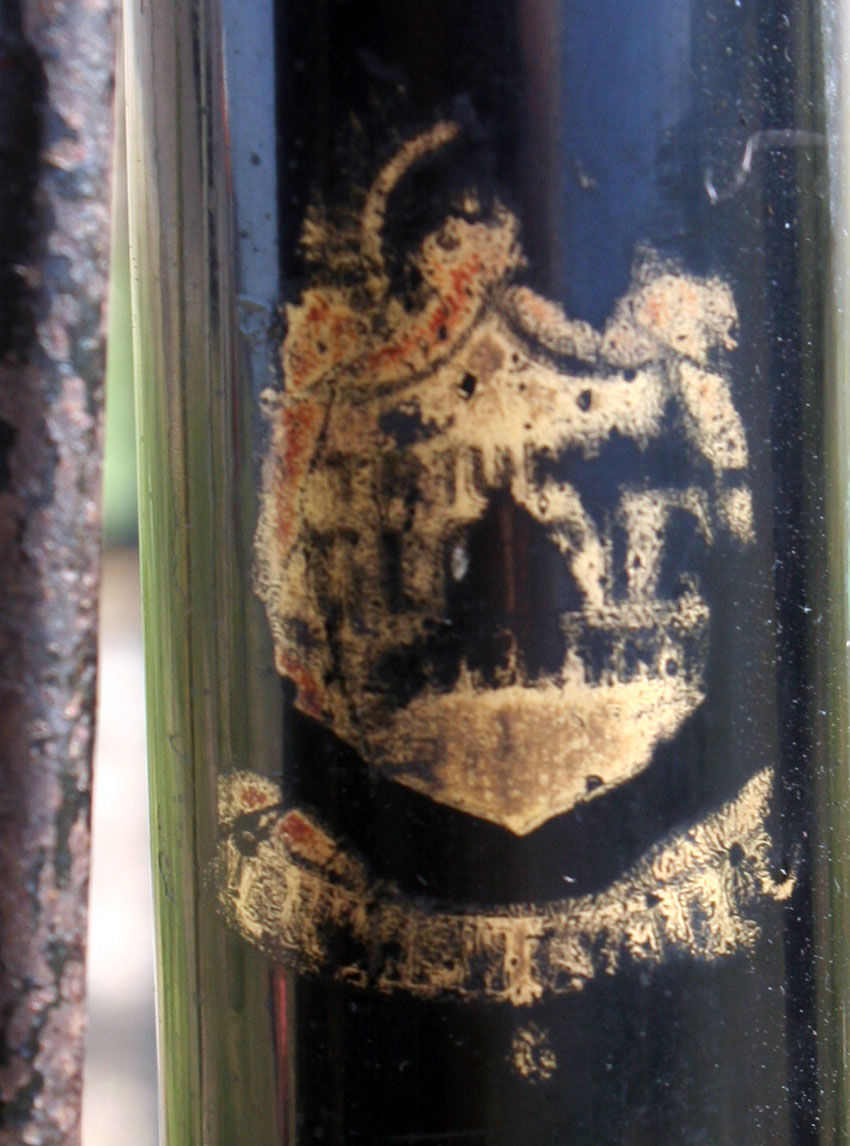

HISTORY OF THE TRIUMPH GLORIA
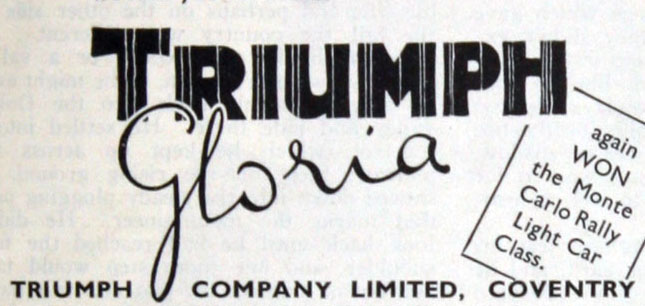
GLORIA CYCLE Co Ltd
Coventry
The Triumph Cycle Co was established in 1896, while the Gloria Cycle Co was apparently set up in Coventry two years later. I’m not sure at what stage Gloria became a subsidiary of Triumph, or whether it was a Triumph company from the outset, but Triumph used both names for their bicycles, the Gloria name being used for cheaper machines.
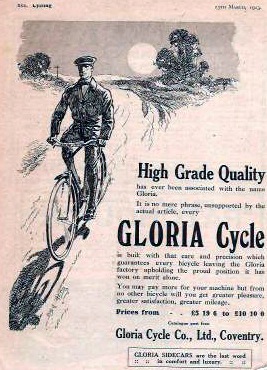
Gloria bicycles were extensively advertised (1913 advert above) and also exported, as can be seen from the following advert in New Zealand’s Wanganui Herald, from 11 November 1903:


With the increasing success of their motorcycle business over the first three decades of the 20th century, that became Triumph’s main focus. This Gloria Roadster would have been one of the last Triumph bicycles to bear the name because, from 1932 the Gloria became a motorcycle and, from 1933, a car.

My first postwar vintage motorcycle was a Triumph Speed Twin Combination purchased in 1973 (bought for £20, crashed, removed damaged sidecar and sold as a solo for £25). A 98cc Gloria (see below) was my first pre-war vintage motorcycle; I owned it from 1980-1993.


In 1933 Triumph Motor Co decided on a change in direction for their car production, and Donald Healey joined the company. The small Triumph saloon cars had helped the company manage through the depression years, but Triumph now decided to add some glory to their four wheelers. They decided the time was right for larger sports saloons, and the result was the Triumph Gloria series. This ran from 1933 to 1937 with around 30 variations based on three chassis lengths, four engine sizes, standard or Vitesse tuned and various bodies.

The Gloria was raced successfully. A 1935 advert in The Motor celebrating Jack Ridley’s 2346 mile run from the Arctic Circle in a Gloria can be seen below.

My favourite style of Triumph Gloria is the Flow-Free Saloon.













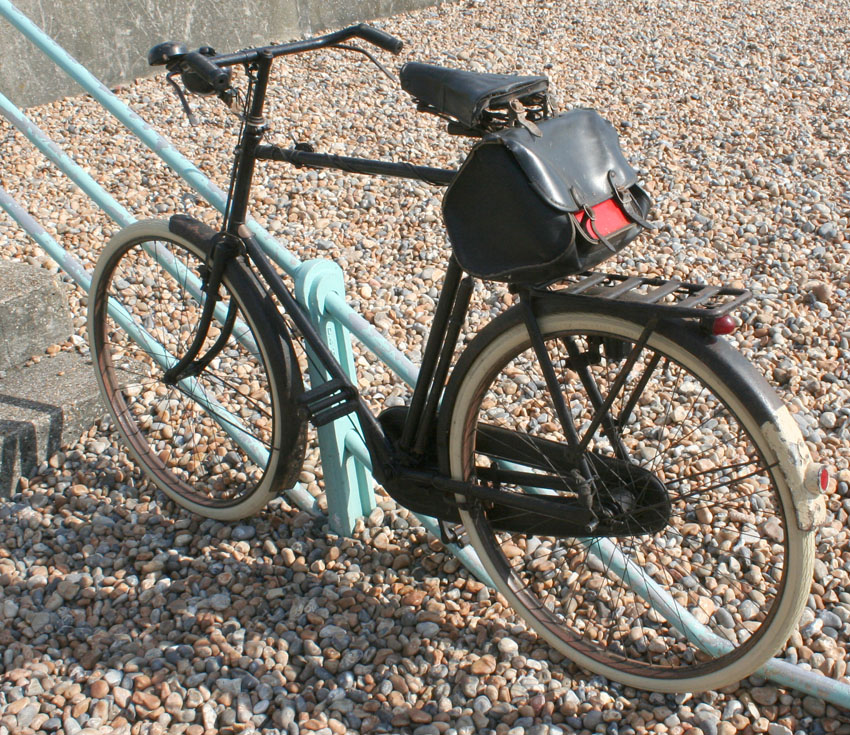

1930 EXCELSIOR TRIUMPH ‘MOTORBIKE’ (AMERICA) v 1931 TRIUMPH GLORIA (GREAT BRITAIN)

Photographing these two contemporaries at Black Rock Station, I was amazed to see how the British Triumph was head and shoulders above its American cousin.

Although the American manufacturers’ ‘motorbike’ style was criticised in the British press, the swept-back handlebar set with crossbar and the ‘motorbike’ tank – which opens to provide a tool-case – are superb features. Nevertheless, it rides terribly! It was only made for a teenager to ride around town; whereas British bikes were commuter machines ridden by adults. The Gloria is well-built and, despite its heavy weight (25kg), with its Sturmey Archer three-speed gears it’s a fast machine.




When I saw this bike it was love at first sight.
Unrequited love is love that is not openly reciprocated or understood as such, even though reciprocation is usually deeply desired. The beloved may or may not be aware of the admirer’s deep affections.
Falling in love with a bicycle? …which beggars the question ‘can a bicycle love you back?’
And how suspect is it to admit loving a Man’s bike named Gloria? How on earth can I talk myself out of this pickle?
Luckily, I happen to know that Triumph Gentlemen’s Bicycles, even if they sport a suspect name such as Gloria, were always made ‘by men, for men.’
The Triumph publicity department proudly announced in its advertising (below) that their products were built by ‘skilled male mechanics only.’
A skilled workman is just as incapable of producing inferior work as an unskilled one of producing good work. Here is the reason for the difference between Triumph bicycles and others. Triumphs are built as no other bicycles – in a MODEL FACTORY by SKILLED MALE MECHANICS ONLY. There is nothing cheap about a Triumph.
Triumph did not trust women in their factory!


As you can see from the pictures, this Gloria is a glorious machine, in original unrestored condition, with the patina one might expect from over eighty years of existence.
This Roadster boasts a full complement of accessories: dynamo, lights, bell, rear carrier, reflector, bag, inflator pump, as well as the piece de resistance …a 1931 penny.






1931 GLORIA CYCLE CATALOGUE






Conveniently, the headlight has an arrow on it to show you which way to go 🙂




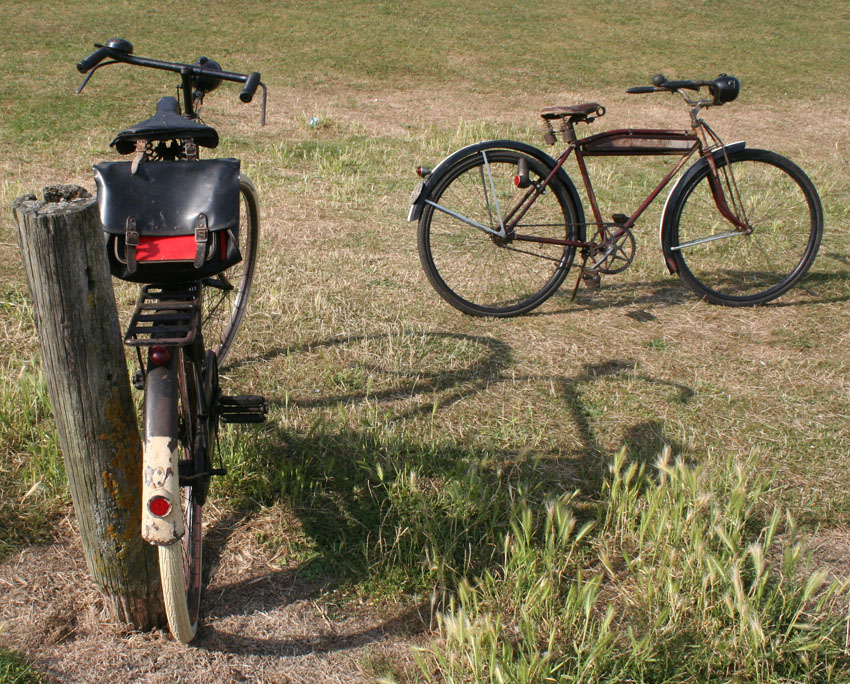

HISTORICAL FOOTNOTES
After Gloria Cycles ended – the name being needed to adorn the latest Triumph Gloria automobile range – the ‘Model H Roadster’ style was continued as part of the Triumph model range. Triumph’s cycle business was sold in 1936, and their machines were no longer exclusive. Compare this 1931 Gloria with the 1939 Triumph Model H Tourist illustrated below.

During WW2, Triumph’s Coventry factory was destroyed by German bombs. After the war, trading as Triumph Cycle Co Ltd, the company mainly produced lightweight sports bikes. In common with the rest of British industry postwar, the majority were exported to the USA to help repay the massive American war debts. BSA took over Triumph Cycle Co Ltd in 1951, and BSA’s cycle division was itself taken over by Raleigh in 1956.
From its start, founded by two German immigrants, Triumph was a quality manufacturer. As a result of World War One, Triumph became the world’s leading motorcycle manufacturer. With Marlon Brando astride one after World War 2, Triumph achieved iconic delinquent status.

Cyclists may not be quite as errant as the ‘Wild One’ but, in my mind, whether your machine sports Triumph motorcycle badges or inverted levers of a WW1 era Triumph bicycle, any vintage machine bearing the Triumph name represents a nostalgic reminder of the time when Great Britain was the Number One world superpower.
























































